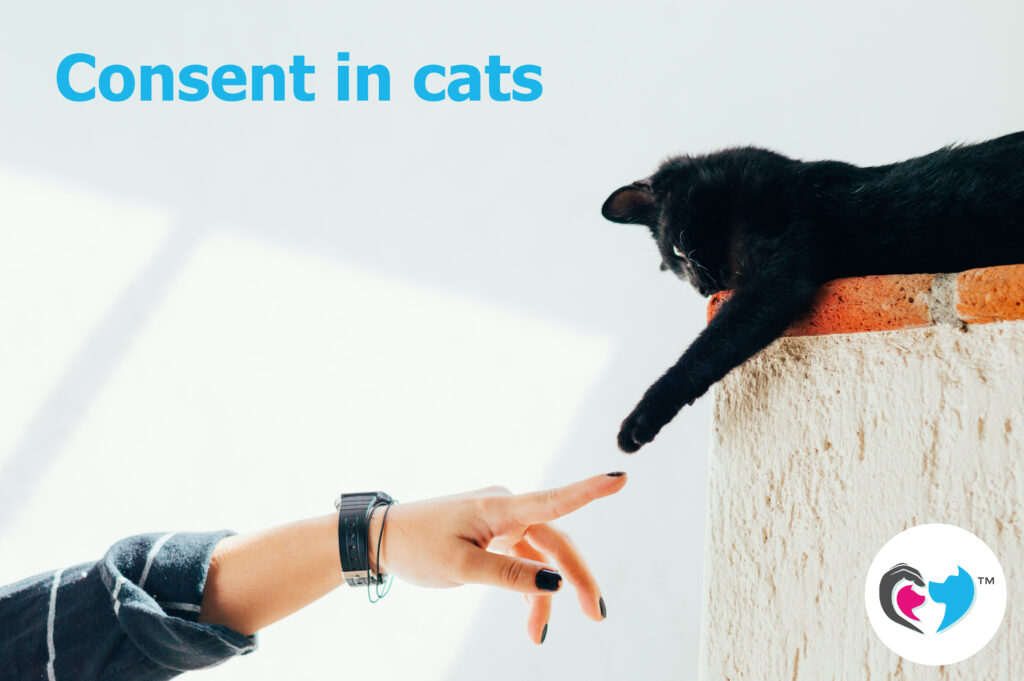In the realm of animal behaviour, understanding the concept of consent is essential for fostering healthy relationships between humans and their pets. While consent may seem straightforward in human interactions, deciphering it in the context of feline behaviour requires a deeper understanding of their communication cues and body language.
Non-Verbal Communication:
Cats communicate primarily through body language, vocalizations, and scent marking. Understanding their non-verbal cues is key to deciphering their consent or lack thereof in various situations (1)
Signs of Consent:
– Active engagement or solicitation: A cat who willingly engages in interactions will typically exhibit a relaxed body posture, with ears forward and tail held upright or gently swaying. If the cat is consenting to an interaction, she will either instigate contact or will ask for more contact if you pause briefly. Do frequent “consent checks” with your cat by occasionally withdrawing your hand if you’re stroking her. If she bunts you or moves toward your hand, she wants the interaction to continue. If she just watches your hand, pulls back, or stays still, she may need a break.
– Affirmative Responses: Purring, rubbing against you, or initiating play are positive indicators that a cat is consenting to interaction.
Recognizing Discomfort:
– Tail Flicking: A flicking or thrashing tail can signal irritation or discomfort, indicating that further interaction may not be welcome.
Lack of interaction can be subtle. If your cat doesn’t reach forward toward you, or just lies still, it can be a sign of him being uncomfortable.
– Hissing or Growling: Vocalizations such as hissing or growling are clear signs that a cat is feeling threatened or uncomfortable and may not consent to further interaction.
Respecting Boundaries:
– Allow Space: Cats value their personal space and may retreat or display defensive behaviours if they feel crowded or overwhelmed. Respect their boundaries by giving them space when needed.
– Time and Patience: Building trust and rapport with a cat takes time and patience. Allow them to approach you on their terms and avoid forcing interactions.
Consent in Handling:
– Gentle Touch: When handling a cat, use gentle, slow movements and let them guide the interaction. Pay attention to their body language and adjust your approach accordingly.
– Watch for Signals: If a cat displays signs of discomfort or tries to retreat during handling, respect their cues and give them space.
Training and Positive Reinforcement:
Teach your cat to associate positive experiences with handling and interactions through training and positive reinforcement techniques. This builds trust and strengthens the bond between you and your cat.
Creating a Safe Environment:
– Provide Safe Spaces: Ensure your cat has access to safe, comfortable spaces where they can retreat and relax undisturbed.
– Minimize Stressors: Identify and minimize stressors in your cat’s environment to create a calm and nurturing atmosphere that promotes consent and well-being.
Understanding and respecting consent in cats is essential for nurturing a harmonious relationship based on trust and mutual respect. By observing their body language, recognizing signs of comfort and discomfort, and adapting our interactions accordingly, we can create a positive and enriching environment where cats feel safe, valued, and understood.
As responsible pet owners and caregivers, let us continue to prioritize the well-being and consent of our feline companions, fostering bonds built on trust, empathy, and respect.
References:
- Bradshaw, J. (2016). The Behaviour of the Domestic Cat. CABI Publishing.





